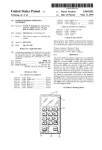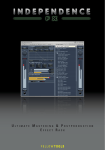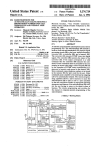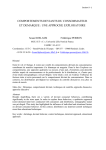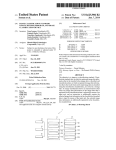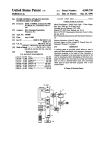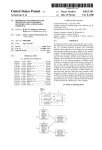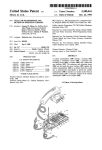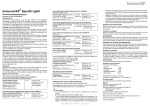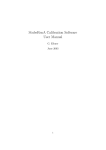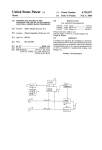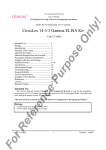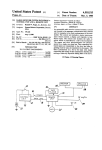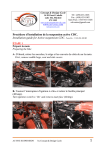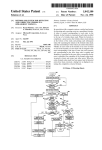Download Radio telephone operating technique
Transcript
US005594778A United States Patent [19] [11] Patent Number: Schaupp, Jr. et a]. [45] Date of Patent: Kirk W. Dailey, Palatine, all of I11. [73] Assignee: Motorola, Inc., Schaumburg, Ill. [21] Appl. No.: 544,742 Oct. 18, 1995 [22] Filed: Related US. Application Data 0023266 1/1987 [51] Motorola, Micro TAC 9800XL, Cellular Portable Tele phone, User’s Manual, 1989. This manual describes the operation of a cellular portable telephone which is currently available. NovAtel 3200/3300 Series, Jan. 1990. Primary Examiner-Curtis Kuntz Assistant Examiner—G. J. Oehling Attorney, Agent, or Firm—Kirk W. Dailey; John G. Rauch ABSTRACT Continuation of Ser. No. 228,173,Apr. 15, 1994, abandoned, which is a division of Ser. No. 650,346, Feb. 4, 1991, abandoned. Int. Cl.6 .................................................. .. H04M 11/00 US. Cl. ............ .. [58] Japan ..................................... .. 379/59 OTHER PUBLICATIONS [57] [60] Jan. 14, 1997 FOREIGN PATENT DOCUMENTS [54] RADIO TELEPHONE OPERATING TECHNIQUE [75] Inventors: George W. Schaupp, Jr., Schaumburg; Laura A. Sheley, Prospect Heights; 5,594,778 . 379/58; 379/59; 379/368 Field of Search ............................... .. 379/58, 59, 368 References Cited [56] U.S. PATENT DOCUMENTS 1/1984 Eibner et al. ......................... .. 346/900 4/1988 Nishida et al. . 9/1988 Allen . 4,872,196 10/1989 Royer et al. . 4,979,207 12/1990 Baum et a1. . 5,007,077 4/1991 Fields et al. ............................ .. 379/88 4,425,627 4,736,410 4,769,516 A radiotelephone (101) has a memory, a display (127) and a keypad (117) with at least one key (121) to produce at least a ?rst function key signal and a second function key_ signal, and a plurality of data keys (119). First, a ?rst function key creates a ?rst function key signal, turning on the radiotele phone (209); second, a phone number is selected (215). Third, the ?rst function key creates a second function key signal from said ?rst function key, activating the radiotele phone to call the phone number (207). Fourth, a second function key creates a third function key signal disconnect ing the radiotelephone from said call (211). Fifth, the second function key creates a fourth function key signal turning oif the radiotelephone (213). \\\ 26 Claims, 6 Drawing Sheets 111 US. Patent Jan. 14,1997 Sheet 1 of 6 5,594,778 /101 Q? 6x I " l‘ H u I! 107 ‘ ' 1“ ®@ HI / / [ ';|l l l I‘ STOP” “In I \ 103 FIGJ H w' l H w “I I US. Patent Jan. 14, 1997 Sheet 2 of 6 5,594,778 501 201 ( START ) (319) 505 \. 213 PUSH STOP 1 PRESS GO (325) 203 507\ STANDBY ENTER A SYMBOL 215 509 \ SELECT NUMBER ' PRESS SCROLL KEY /' TO LOCATE DESIRED 211 PUSH NAME (331) 511 PRESS GO 519 US. Patent Jan. 14,1997 5,594,778 Sheet 4 of 6 401 I STATE fT'NTER SEQUENCE OF 403 DATA KEYS / 415 YES 417 SEQUENCE CORRECT? / 405 PRESS AND HOLD STOP KEY 407 RELEASED AFTER FIRST BEEP? 413 \ '411 CLEAR TI- E LAST DATA KEY INPUT CLEAR THE ENTIRE DATA KEY INPUT YES YES RELEASED AFTER SECOND BEEP? FIG.5 / 409 US. Patent Jan. 14, 1997 Sheet 5 of 6 5,594,778 /\ 607 I START ) (319) FIG.7 / 503 PRESS GO (323) / 605 PRESS GO / 607 ENTER PHONE NUMBER WITH DATA KEYS / 609 PREss GO / 611 ENTER NAME WITH DATA KEYS / 615 PRESS GO SPECIFY MEMORY LOCATION? YES / 623 625 \ ENTER MEMORY PREss GO LOCATION wITI-I DATA KEYS 627 \ l PRESS G0 I US. Patent Jz‘m.14,1997 Sheet 6 of 6 5,594,778 701 703 START \ PRESS MENU KEY 705\ SELECT FUNCTION WITH DATA KEYS F .I. G 8 PRESS GO NO CORRECT MODE? PRESS STOP 713 FIG.9 901 r___________/_ w / 905 909 TRANSMITTER 903 USER INTERFACE DIGITAL COMPUTER RECEIVER 90 7 COMPUTER PROGRAM STORAGE MEDIUM I l l l l l l l l I l l 5,594,778 1 2 RADIO TELEPHONE OPERATING display and a keypad with at least one key to produce at least a ?rst function key signal and a second function key signal, and a plurality of data keys. TECHNIQUE This is a continuation of application Ser. No. 08/228,173, ?led Apr. 15, 1994 now abandoned which is a continuation The method comprises creating a ?rst function key signal from a ?rst function key to turn on the radiotelephone; of application Ser. No. 07/650,346, ?led Feb. 4, 1991 and selecting a phone number; creating a second function key signal from said ?rst function key, activating the radiotele~ phone to call said phone number; creating a third function key signal from a second function key disconnecting the radiotelephone from said call; and creating a fourth function key signal from said second function key, turning off the now abandoned. FIELD OF THE INVENTION This invention is generally related to radiotelephones and more speci?cally to methods of operating a radiotelephone. radiotelephone. BACKGROUND OF THE INVENTION BRIEF DESCRIPTION OF THE DRAWINGS There is essentially one known technique of using a keypad for controlling a radiotelephone. The technique uses FIG. 1 is a drawing of an embodiment which may include from four to twelve function keys in addition to the standard twelve key data pad and it includes a display for the data input. The function keys generally include some or all of the 20 following functions: send, end, power, recall, store, clear, function, name, volume and menu. The number and type of keys depends on the manufacturer and the features on the phone. The function keys which are essential to the operation of the phone are the send, end, power and clear keys. The send 25 key is used to initiate a phone call to the number entered with the data keys and located in the display. The end key is used to end a phone call. The power key is used to turn the radiotelephone on and off with successive key activations. present invention. memory of a radiotelephone in accordance with the present invention. FIG. 7 is a process ?owchart of storing a name and a one character of data or the entire display of data, depending on how the key is used. phone number in the memory of a radiotelephone in accor dance with the present invention. There are three keys which can be used to store and recall 35 FIG. 8 is a process ?owchart of selecting a mode of a menu function of a radiotelephone in accordance with the present invention. store key is used to store data into a memory location. First, the data is entered into the radiotelephone with the data keys, then the store key is pressed, followed by a memory location entered with the data keys. This data can be either symbols, representing names or numbers representing phone num bers. The recall key followed by an appropriate memory ’ FIG. 6 is a process ?owchart of recalling a name from the The clear button is used when entering data to clear either names and phone numbers from the radiotelephone memory, namely, the store key, the recall key, and the name key. The the present invention. FIG. 2 is drawing of an alternate embodiment which may include the present invention. FIG. 3 is a state diagram of a basic phone call in accordance with the present invention. FIG. 4 is a state diagram of selecting a phone number in accordance with the present invention. FIG. 5 is a process ?owchart of clearing data input from the display of a radiotelephone in accordance with the FIG. 9 is a block diagram of a radiotelephone which may employ the present invention. 40 DESCRIPTION OF A PREFERRED EMBODIMENT location will recall the phone number or name contained FIG. 1 reveals a ?rst embodiment of the disclosed inven within that memory location. The name key is used to tion. The radiotelephone 101 contains a display 111, a 45 activate a menu of names which have phone numbers keypad 103 which has a standard 12 data keys 105, plus two corresponding to them. The user can scroll through the menu additional function keys 107 and 109. The standard 12 data of names using the “#” and the “*” keys. There are other keys which activate features of the phone which vary between manufacturers. The function key is used to activate other features of the phone denoted by the number input with the data keys which follow activation of the function key. Finally, the menu key is used to access a menu of advanced features which can be scrolled through using the “#” and the “*” keys. With thorough knowledge of the operation of these keys, a complicated radiotelephone can be successfully operated. However, a high percentage of people do not access the advanced features of the phone because of lack of under standing of the complexities involved in such use. There fore, there exists a need for an improved technique for operating a radiotelephone; one in which the operation of the radiotelephone is intuitive to the uneducated user. SUMMARY OF THE INVENTION The present invention encompasses a method of operating a radiotelephone. The radiotelephone has a memory, a keys contain the numbers from 0 to 9, the “#” key and the “*” key. The two additional function keys are the go key 107 50 and the stop key 109. FIG. 2 reveals a second embodiment of the disclosed invention it is a radiotelephone 115 having a display 127, a 55 60 keypad 117 containing a standard 12 data key inputs 119 containing symbols on the keys as follows: Data key 2 containing number 2 and alpha characters A, B, and C, data key 3 containing D, E and F, data key 4 containing G, H and I, data key 5 containing J, K and L, data key 6 containing M, N and 0, data key 7 containing P, R and S, data key 8 containing T, U and V, and data key 9 containing W, X and Y. The “*” and “#” keys contain directional arrows. Although in this embodiment alpha characters are used, other symbols may substituted such as kata-kana, as described in US. Pat. No. 4,872,196, issued on Oct. 3, 1989 on behalf of Paul Royer et 21., with the same assignee as the 65 present invention, titled “Telephone Keypad Input Device”. The keypad 117 also contains three function buttons, 121, 123, 125. These are the go key 121, the menu key 123 and 5,594,778 3 4 the stop key 125. The operation of these three function keys in the operation of the radiotelephone 101 follows. the user into close proximity to the name in which he wants to recall. For example, on a standard key input, if the user was to recall Bill, he would press data key 2 because it contains the letters A, B and C. Next, the user would use the scroll keys located on the “*” and “#” keys to scroll either FIG. 3 is a state diagram of a basic phone call in accordance with the present invention. The four states are the off state 201, the standby state 203, the dialing state 217 and the talking state 205. In general, to transfer states the user must press a data key 119, the stop key 125 or the go key 121. Speci?cally, to transfer from the off state 201 to the standby state 203 the user must select the go key 209. Moving from the standby state 203 to the o?” state 201 the in ascending alphabetical order or descending alphabetical order at 509 until the name is located. After the correct name is displayed on the radiotelephone 101, the go key 121 is pressed at 511, this completes the process of recalling a name from memory 907 and is the transition state 331 noted user must select the stop key 213. In order to move from the standby state to the dialing state 217, the user must select a number 215. Moving from the dialing state 217 to the talking state 205 requires pushing the go key 207. To transfer from the talking state 205 to the standby state 203, the user 15 must push the stop key 211. FIG. 4 is an exploded view of selecting a number 215 and the dialing state 217 from FIG. 3. There are three states within the dialing state 217: normal dialing state 305, in FIG. 4. FIG. 7 reveals the process which is used to enter phone numbers and corresponding names into the memory 907 of a radiotelephone 101 according to the present invention. The process starts at 601. At 603, the user presses the go key 121, entering the symbol mode state 307. At 605, the user presses the go key 121, enter the inputting name and number state 311. Here, the user selects the sequence of data keys representing a phone number. At 609, the user presses the go key 121 to store the number into the memory 907. At 611, recalling a number state 303, and recalling a name state 309. 20 the user enters the name which correlates to the above In order to transition between standby state 301 and the number with the data keys 119. Symbols can be entered with normal dialing state 305 the user must select a sequence of data keys which represent a phone number 317, for this embodiment the sequence must be larger than two data keys. the standard keypad data keys 119 by depressing the des ignated data key a selected number of times. For example, recalling number state 303 the user must select a sequence the following data keys: 22 “#” 444 “#” 555 “#” 555. An In order to transition between standby state 301 and the 25 when entering the word Bill into the display one would push of data keys which represent a memory 907 location within the memory of the radiotelephone 101, for this embodiment it is one or two data keys. In order to transition between the recalling name state 309 and the standby state, the user must 30 ?rst transfer to the symbol mode state 307 by pressing the go key 319. The transfer from the symbol mode state 307 to the alternate method of entering symbols is realized by pressing and holding the designated data key, the display 127 will scroll through the available symbols and when the key is released it holds the last displayed symbol. At any time during this data entry process the user may use the clear process as described in FIG. 5 to clear data key entries. At 615, after the symbol is entered correctly, the user presses recalling name state 309 requires the user to enter a data key the go key 121. At 621, the user decides whether to enter the 119 which represents the symbol closest to the name in which the user is trying to recall at 325. Once the user has 35 speci?c memory location. If the user wants to enter the memory location, at 623 the memory location is entered with reached one of the dialing states 303, 305,309 pressing the go key 331 will place the radiotelephone 101 into the talking the data keys 119 and at 627 the go key 121 is pressed. If the state 313. Once in the talking state 313, one may press the stop key 333 which will end the call and return the caller to user does not want to enter the memory location, then the go key 121 is pressed at 625 and the name and phone number are stored in the next available memory location. Optionally, the standby state 301. While in the symbol mode state 307, the user may input the new names and phone numbers into the user has the option of inputting a new name and phone number instead of recalling a name and phone number. This the radiotelephone 101 by ?rst selecting the “#” key and releasing it after two beeps have sounded. This would place can be accomplished by pressing the go key 323, thereby, transferring from the symbol mode state 307 to the inputting name and number state 311. While in the inputting name and 45 number state 311, pressing the go key 321 will return the user to the standby state 301. the user at 607 in the preceding process. FIG. 78 is a process ?ow chart of selecting modes of the menu functions. The functions include locking the phone, resetting the call timers, changing the unlock code or any of the functions that are available on a radiotelephone. The At any point in time when entering a sequence of data process starts by pressing a menu key at 703. The menu key keys it may be necessary to clear one of the inputs or the entire data input depending upon how severe the mistake. 50 can be activated by holding down the “*” key until two beeps sound or by pressing a menu function key 123, as FIG. 5 reveals the process for clearing data from the display shown in FIG. 2. At 705, the user enters the number 111. First, the process starts at 401, at 403 the user enters the representing the function with the data keys 119. Typically, sequence of the data keys 105, the user then will visually there is a user’s manual that accompanies all phones that check the display 111 to see if the data is correct at 417. At 405, if it is not correct the user must press and hold the stop 55 states the numbers of each function. At 707, the go key 121 is pressed and the display shows the current mode of the key 109. If the user wants to clear the last data key input at function. If the mode is correct, at 711 the user presses the 411, then the stop key 109 must be released after the ?rst stop key 125. If the mode is not correct, at 707 the user beep at 407. If the entire data key input is to be cleared at 413, the stop key 109 must be released after the second beep at 409. This process is repeated until the data displayed is presses the go key 121. The radio telephone will either 60 toggle between two modes or step to the next mode if there correct, then process is stopped at 415. FIG. 6 is the process ?owchart for recalling a name from memory 907 which is part of the dialing state 217. The process is started at 501. At 505, the user presses the go key 121, this is also shown in FIG. 4 as transition action 319. Secondly, the user must enter 65 are more than two possible modes. After the correct mode is selected at 709, the user presses the stop key at 711 and it stores the proper mode of the function into the memory 907 of the radiotelephone 101. FIG. 9 is a block diagram of a radiotelephone 901 which a data key 119 which represents the symbol closest to the may employ the present invention. The radiotelephone 901 name in which the user is trying to recall at 507. This puts includes a computer program storage medium 907, com~ 5,594,778 5 6 monly referred to as a memory device, a digital computer 909, and an user interface 905. The user interface 905 further comprises the step of creating, responsive to said displaying said symbol sequence, a seventh function key signal solely responsive to a third single-throw function key, advancing the display one symbol sequence in memory. includes a microphone, a speaker, a display, data keys and function keys. The display, data keys and function keys are illustrated in FIG. 1 and FIG. 2. The computer program 5 7. A method of operating a radiotelephone in accordance with claim 1 wherein said selecting said phone number further comprises the steps of: creating an eighth and ninth function key signal solely responsive to said ?rst single-throw function key; storage medium 907, the digital computer 909 and the user interface 905 used in conjunction with each other to form a radiotelephone operations controller. The radiotelephone operations controller controls the function of the radiotele phone 901. selecting a third sequence of the data keys which repre sent a phone number; Described herein is a method of controlling the functions of a radiotelephone with only two or three function keys. The radiotelephone 101 has many of the advanced functions creating a tenth function key signal solely responsive to said ?rst single-throw function key; of current radiotelephones without the complexity involved in utilizing the functions of the current radiotelephones. The selecting a fourth sequence of designated data keys in succession a predetermined number of times to desig functions as described are intuitive to the uneducated radio telephone user. What is claimed is; nate an symbol sequence; and creating an eleventh function key signal solely responsive to said ?rst single-throw function key. 1. A method of operating a radiotelephone, the radiotele phone including a memory, a display and a keypad with at least a ?rst single-throw function key, a second single-throw function key, and a plurality of data keys, the method with claim 1 wherein said selecting said phone number further comprises the steps of: comprising the steps of: creating a ?rst function key signal solely responsive to the selecting a ?fth sequence of data keys which represent a phone number or a memory location; and 8. A method of operating a radiotelephone in accordance creating a twelfth function key signal solely responsive to said second single-throw function key for a ?rst pre ?rst single-throw function key to turn on the radiotele phone; determined length of time, thereby clearing the last data selecting a phone number using the plurality of data keys; creating a second function key signal solely responsive to said ?rst single-throw function key activating the radio key signal input. 9. A method of operating a radiotelephone in accordance with claim 1 wherein said selecting said phone number further comprises the steps of: telephone to call said phone number; creating a third function key signal solely responsive to the second single-throw function key disconnecting the selecting a sixth sequence of data keys which represent a phone number or a memory location; and radiotelephone from said call; creating a thirteenth and fourteenth function key signal solely responsive to said second single-throw function key, thereby clearing said sequence of data input. 10. A method of operating aradiotelephone in accordance with claim 1 wherein said selecting said phone number further comprises the steps of: selecting a seventh sequence of data keys which represent creating a fourth function key signal solely responsive to said second single-throw function key turning off the radiotelephone; and wherein said ?rst single-throw function key does not revert back to creating said ?rst function key signal unless said fourth function key signal has been created. 2. A method of operating a radiotelephone in accordance with claim 1 wherein said selecting said phone number further comprises step of selecting a ?rst sequence of the data keys which represent a phone number. 3. A method of operating a radiotelephone in accordance with claim 1 wherein said selecting said phone number further comprises the step of selecting a second sequence of the data keys which represent a memory location within the memory of the radiotelephone. 4. A method of operating a radiotelephone in accordance with claim 1 wherein said selecting said phone number further comprises the steps of: creating a ?fth function key signal solely responsible to said ?rst single-throw function key; selecting a ?rst designated data key representing a sym bol; and a phone number or a memory location; and creating a ?fteenth function key signal solely responsive to said second single-throw function key for a second predetermined amount of time, thereby clearing said 45 comprising the steps of: creating, responsive to said creating said ?rst function key signal, a sixteenth and a seventeenth function key 55 displaying a symbol sequence from the memory whose ?rst symbol is alphabetically closest to said symbol. 5. A method of operating a radiotelephone in accordance with claim 4 wherein said selecting said phone number further comprises the step of creating, responsive to said displaying said symbol sequence, a sixth function key signal solely responsive to a third single-throw function key, scroll ing the memory in alphabetical order until said third single throw function key is released. 6. A method of operating a radiotelephone in accordance with claim 4 wherein said selecting said phone number sequence of data input. 11. A method of operating a radiotelephone in accordance with claim 1 further comprising programming the radiotele phone with a phone number and a name, the programming signal solely responsive to said ?rst single-throw func tion key; selecting an eighth sequence of the data keys representing the phone number; creating an eighteenth function key signal solely respon sive to said ?rst single-throw function key; selecting a ninth sequence of designated data keys in 60 succession a predetermined number of times to desig nate the name; and creating a nineteenth function key signal solely respon sive to said ?rst single-throw function key. 65 12. A method of operating a radiotelephone in accordance with claim 1 further comprising the steps of: creating, responsive to said creating said ?rst function key signal, a twentieth function key signal solely respon 5,594,778 8 7 further comprises the step of selecting a second sequence of the data keys which represent a memory location within the memory device of the radiotelephone. 17. A method of operating a radiotelephone in accordance with claim 14 wherein said step of selecting said phone number further comprises the steps of: sive to a third single-throw function key for a third predetermined length of time; selecting a tenth sequence of the data keys representing a ?rst function of the radiotelephone; creating a twenty-?rst function key signal solely respon sive to said ?rst single-throw function key designating depressing solely the ?rst uni-directional function key; selecting a ?rst designated data key representing a sym bol; and a ?rst mode of said function; creating a twenty-second function key signal solely responsive to said ?rst single-throw function key des ignating a second mode of said function; and 10 setting said feature in said second mode. 13. In a radiotelephone having a radiotelephone opera tions controller for use with a digital computer disposed within a radiotelephone, the radiotelephone operations con further comprises the step of solely depressing, responsive 15 order until said third uni-directional function key is released. 19. A method of operating a radiotelephone in accordance with claim 17 wherein said selecting said phone number a ?rst single-throw function key; a second single-throw function key; and a computer program storage medium having a computer program stored thereon to be executed by the digital computer, the computer program operative to: switching the radiotelephone on in response to a ?rst function key signal solely responsive to said ?rst 25 initiating a phone call in response to a second function key signal solely responsive to said ?rst single-throw 30 solely responsive to said ?rst single~throw function key; terminating a phone call in response to a fourth func tion key signal solely responsive to said second single-throw function key; 35 switching the radiotelephone off in response to a sixth succession a predetermined number of times to desig nate a symbol sequence; and further comprises the steps of: function key signal solely responsive to said second single-throw function key; and ' selecting a ?fth sequence of data keys which represent a phone number or a memory location; and wherein the ?rst single-throw function key does not depressing solely the second uni-directional function key for a ?rst predetermined length of time, thereby clear— ing the last data key signal input. revert back to switching the radiotelephone on unless the radiotelephone has been switched 01f in response 45 22. A method of operating a radiotelephone in accordance with claim 14 wherein said selecting said phone number further comprises the steps of: selecting a sixth sequence of data keys which represent a phone number or a memory location; and depressing solely and releasing the second uni-directional function key twice, thereby clearing said sequence of data input. number; (1) depressing solely a second uni—directional function key, 55 e) depressing solely a second uni-directional function key, turning off the radiotelephone; and 23. A method of operating a radiotelephone in accordance with claim 14 wherein said selecting said phone number further comprises the steps of: selecting a seventh sequence of data keys which represent a phone number or a memory location; and wherein the ?rst uni-directional function key does not revert back to turning on the radiotelephone unless the radiotele phone has been turned off in response to depressing solely the second uni-directional function key. 15. A method of operating a radiotelephone in accordance with claim 14 wherein said selecting said phone number further comprises the step of selecting a ?rst sequence of the data keys which represent a phone number. 16. A method of operating a radiotelephone in accordance with claim 14 wherein said selecting said phone number solely depressing and releasing the ?rst uni-directional function key; selecting a fourth sequence of designated data keys in 21. A method of operating a radiotelephone in accordance with claim 14 wherein said selecting said phone number signal solely responsive to said second function key; deactivating the phone call; selecting a third sequence of the data keys which repre sent a phone number; solely depressing the ?rst uni-directional function key. clearing a data entry in response to a ?fth function key to the sixth function key signal. 14. A method of operating a radiotelephone comprising the steps of: a) depressing solely a ?rst uni-directional function key, turning on the radiotelephone; b) selecting a phone number using a plurality of data keys; 0) depressing solely the ?rst uni-directional functional key, activating a phone call to the selected phone further comprises the step of solely depressing and releas ing, responsive to said displaying said symbol sequence, a third uni-directional function key, advancing the display one symbol sequence in memory. 20. A method of operating a radiotelephone in accordance with claim 14 wherein said selecting said phone number further comprises the steps of: solely depressing and releasing the ?rst uni-directional function key twice; function key; /, storing a name and a phone number in a memory location in response to a third function key signal to said displaying said symbol sequence, a third uni-direc tional function key, scrolling the memory in alphabetical troller comprising: single-throw function key; displaying a symbol sequence from the memory whose ?rst symbol is alphabetically closest to said symbol. 18. A method of operating a radiotelephone in accordance with claim 17 wherein said selecting said phone number creating a twenty-fourth function key signal solely responsive to said second single-throw function key, depressing solely the second uni-directional function key 60 for a second predetermined amount of time, thereby clearing said sequence of data input. 24. A method of operating a radiotelephone in accordance with claim 14 further comprising programming the radio telephone with a phone number and a name, the program 65 ming comprising the steps of: depressing solely, responsive to step a), the ?rst uni directional function key twice; 5,594,778 10 9 a ?rst single-throw function key; a second single-throw function key; a computer program storage medium having a computer program stored thereon to be executed by the digital computer, the computer program operative to: selecting an eighth sequence of the data keys representing the phone number; depressing solely the ?rst uni-directional function key; selecting a ninth sequence of designated data keys in succession a predetermined number of times to desig nate the name; and switching the radiotelephone on solely responsive to ' depressing solely the ?rst uni-directional function key. 25. A method of operating a radiotelephone in accordance with claim 14 further comprising the steps of: depressing the ?rst single-throw function key a ?rst 1O depressing solely, responsive to step a), a third uni~ directional function key for a third predetermined length of time; the ?rst single-throw function key a second time; storing a name and a phone number in a memory location solely responsive to depressing the ?rst 1 selecting a tenth sequence of the data keys representing a ?rst function of the radiotelephone; 15 depressing solely the ?rst uni-directional function key designating a ?rst mode of said function; depressing solely the ?rst uni-directional function key designating a second mode of said function; and depressing solely the second uni-directional function key, setting said feature in said second mode. 26. In a radiotelephone having a radiotelephone opera tions controller for use with a digital computer disposed within a radiotelephone, the radiotelephone operations con troller comprising: time; initiating a phone call solely responsive to depressing 20 single-throw function key a third time; terminating a phone call solely responsive to depress ing the second single-throw function key a ?rst time; switching the radiotelephone off solely responsive to depressing the second single-throw function key a second time; and wherein the ?rst single-throw function key does not revert back to switching the radiotelephone on unless the radiotelephone has been switched off by the second single-throw function key. * * * * * UNITED STATES PATENT AND TRADEMARK OFFICE CERTIFICATE OF CORRECTION PATENTNO. ; DATED 5,594,778 January 14, 1997 mvewroms) : Schaupp, Jr. et al. It is certified that error appears in the above-identi?ed patent and that said Letters Patent is hereby corrected as shown below: Title Page Item [57], Abstract In line 8, please delete the phrase “from said ?rst function key,”. Claim 2 In column 5, line 42, after the phrase “further comprises”, please insert --the--. Claim 4 In column 5, line 53, please replace “responsible” with --responsive--. Signed and Sealed this Thirtieth Day of December, 1997 A nest: éiwuhk BRUCE LEHMAN Arresting O?icer C'ommLu-inner 0f Pulents and Trademarks













